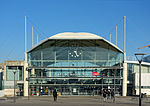Verrières-le-Buisson
Communes of EssonneEssonne geography stubsPages including recorded pronunciationsPages with French IPAPages with disabled graphs

Verrières-le-Buisson (French pronunciation: [vɛʁjɛʁ lǝ bɥisɔ̃] ) is a commune in the southern suburbs of Paris, France. It is 13.3 km (8.3 mi) from the centre of Paris, in the Essonne department just outside the inner ring of the Île-de-France. The commune borders the river Bièvre.
Excerpt from the Wikipedia article Verrières-le-Buisson (License: CC BY-SA 3.0, Authors, Images).Verrières-le-Buisson
Place Charles de Gaulle, Palaiseau
Geographical coordinates (GPS) Address Nearby Places Show on map
Geographical coordinates (GPS)
| Latitude | Longitude |
|---|---|
| N 48.7464 ° | E 2.2674 ° |
Address
Mairie de Verrières-le-Buisson
Place Charles de Gaulle
91370 Palaiseau
Ile-de-France, France
Open on Google Maps









